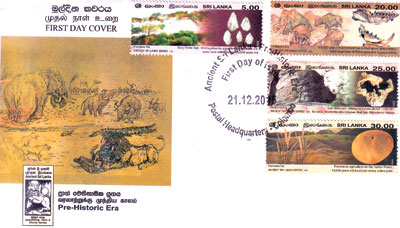‘Ancient Sri Lanka’ is a series of interesting stamps released by the Philatelic Bureau. Three sets have been released so far.
Archaeologists identify the history of the country’s primitive inhabitants as the Prag History Age. It has been revealed that around 125,000 years ago the country’s inhabitants possessed the technical skills to make structures using stones and fragments of bones.
This primitive period has been divided into three on the basis of archaeological findings and the types of physical remnants like bones as well as materials used by the people. The divisions are: the Paleolithic Age - the period of the most primitive; Mesolithic - the period when prag (pre-historic) modern man lived; and Neolithic - when people were engaged in agro-economics utilising metals for various purposes.
Professor Siran Deraniyagala in his research had found that stone tools and equipment had been used in the lower Paleolithic age - the period beyond 250,000 years. These have been discovered from deposits beneath the earth layers and are believed to have been used by the homo habilis type of man. The Rs. 5 stamp depicts such stone tools belonging to the middle Paleolithic age some 125,000 years ago. People of that age are said to have made these tools from a stone variety known as ‘tirivaana’ adopting the best available technology. They had used these tools to hunt animals and to process their meat.
On the left is Mihihagalkanda, identified as an early habitat area on the southern coastal belt adjoining the Panama area. This is deemed to be the first habitat area dating back to 300,000 years.
There is evidence to show that during this period animals with single horns like the hippopotamus, rhinoceros and the unicorn and an elephant species which no longer exists, were endemic to Sri Lanka. The fossils of these animals, seen in the Rs. 20 stamp have been found in the Ratnapura gem pits. This stamp also shows bone fragments of the rhino and the hippo.
The Mesolithic age dates back to 40,000 years and beyond. Small size tools have been used during this time and the type of man representing this period is known as ‘homo sepeane sepunane’ or the prag modern man. These people were widely spread throughout the country.
Wet zone places like Batadomba-Lena (cave) in Kuruwita (portrayed in the Rs. 25 stamp), Beli-Lena in Kitulgala, Phahiyangala-Lena, Asmadalagala in Avissawella where the Maniyangama Beli-Lena is believed to exist, as well as caves in the dry zone in places like Sigiriya, Aligala and Pothana, and fossil deposits in coastal zones like Pallemalala bear evidence that man lived in those areas.
The human skull seen in the stamp was discovered from a cemetery from Bellanbandi Pelessa, where several collections of bones and skulls have been found. These remnants are believed to be around 7,000 years old.
As for the Neolithic age, researchers face some controversy. However, there is evidence of a rich agricultural scenario during the period over 13,000 years ago. Pre-historic agriculture in Horton Plains is depicted in the Rs 30. stamp, pointing to the existence of barley crops 13,000 years ago. The barley pollen grain shown on the right has been enlarged 3,000 times.
|


